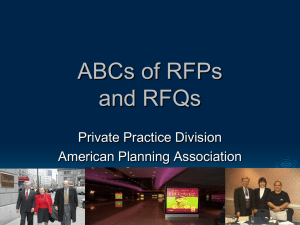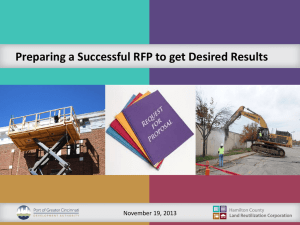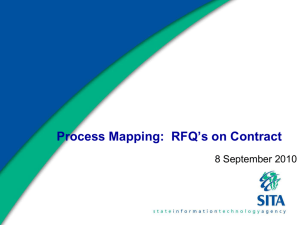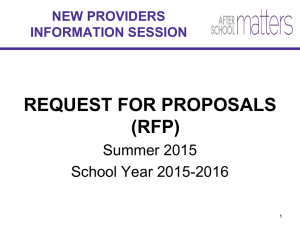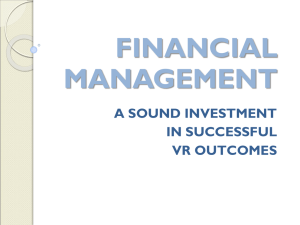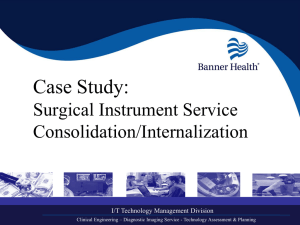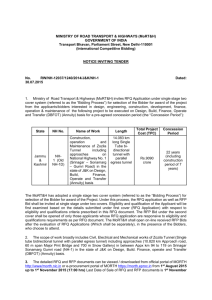RFQ / RFP Best Practices Workshop
advertisement
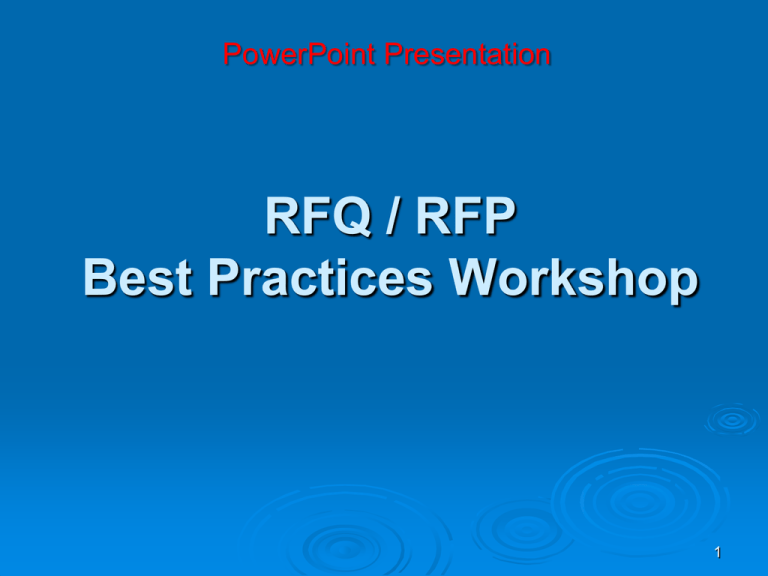
PowerPoint Presentation RFQ / RFP Best Practices Workshop 1 Presented by (Insert name of presenting organization) (Insert name and contact info for instructor) 2 Purpose This workshop outlines the best practices for selection of various service providers involved in the design and construction process These team members are typically selected through the Request for Qualifications (RFQ) and Request for Proposal (RFP) process The practices described in this workshop are recommended for use by any entity procuring such services from service providers 3 Definitions of RFQ & RFP A Request for Qualifications (RFQ) is a document issued by a buyer of services to sellers of services, requesting documentation of their general qualifications and experience, to determine whether such sellers are qualified to provide the services required by the buyer. The buyer will typically use the information received in the RFQ process to develop a selected list of best qualified providers. The buyer will then typically issue an RFP to those best qualified providers. A Request for Proposal (RFP) is a document issued by a buyer of services to sellers of services, requesting much more specific documentation of their experience, capabilities, resources and related costs, thereby allowing the buyer to determine which seller is best suited to complete the specific assignment required by the buyer 4 When to Use RFQs & RFPs RFPs and RFQs are typically used for: Qualifications Based Selection Best Value Selection Based on Fees Best Value Selection Based on Total Cost RFQs can also be used for: Prequalification of service providers 5 Team Selection Principles 6 Team Selection Principles 1. 2. 3. 4. 5. 6. All RFQ / RFP information must be provided to all respondents, including responses to all questions Selection criteria must be clearly identified and communicated to the respondents Weighting of selection criteria must be identified and communicated to all respondents Selection criteria and weighting must be strictly followed by the Selection Committee Results of the Selection Matrix must be provided to all respondents (respondent names may be concealed) Transparency and fairness must be maintained throughout the process 7 Selection Committee Guidelines 8 Selection Committee Guidelines 1. 2. 3. 4. It is recommended that the Selection Committee be limited to no more than seven members, representing the major project stakeholders Participation by those with working knowledge of the profession being selected is recommended Confirm that all Committee participants are prepared to devote the time and effort necessary to complete the process properly Confirm that all Committee members understand the team selection principles and process, providing training to any individuals as necessary 9 RFQ / RFP Best Practices Most of the best practices contained in this workshop apply to both RFQs and RFPs. Whenever this is not the case, it will be noted. 10 Content of Invitations Invitations to respond to RFQs and RFPs should contain the following information, at minimum: Name, address and contact information (phone and email) for entity requesting the response Date and time when response is due Basic description (one paragraph) of the services being procured Date, time and location of any required on-site visits or pre-response meetings A requirement that invited respondents confirm by a specific date and time whether or not they will submit a response to the RFQ / RFP 11 RFQ / RFP Content & Structure 12 Contact RFQs and RFPs must include the name and contact information (phone and email) of the individual to whom questions should be addressed Contact should be limited to the individual noted above; contact to other Committee Members should be deemed to be grounds for disqualification of respondent All questions should be directed to one individual, and all responses to questions should be issued by one individual, to eliminate the possibility of conflicting responses All questions must be documented and responses to all questions must be provided in writing to all respondents Provide contact information for others with whom respondents must interact, such as security personnel for site visits, if applicable 13 Context RFQs & RFPs should include the following contextual information: Basic information about the entity issuing the request (organization’s mission, size of organization, etc.) Any history relevant to the assignment Schedule for every significant step in the entire RFQ / RFP process, from date of issuance to final decision (Date request issued, last date for questions, etc.) Any additional information which would be beneficial to the respondents’ understanding of the assignment 14 Objectives & Scope of Services Define your project objectives in very clear terms Define the scope of the required services in very specific terms Failure to clearly identify your objectives and the scope of the required services will likely lead to responses which cannot be fairly compared 15 Contractual Requirements Identify the form of contract (and general conditions, if applicable) to be utilized for the assignment Clearly identify any affirmative action, local participation or similar requirements Clearly define any confidentiality requirements 16 Minimum or Unusual Requirements If there are any threshold requirements, identify them very clearly, so as not to waste your time or the respondents’ efforts (Examples: Respondent’s main office must be located in the state in which the project is located; work must be performed under a Project Labor Agreement, etc.) If there are any unusual requirements, provide details (Example: All work must be performed on weekdays between 7:00 PM and midnight) 17 Selection Criteria Clearly identify the criteria upon which your selection will be based (Experience with relevant assignments, safety record confirming safe performance, etc.) Clearly identify the weighting of each of the selection criteria (Example: Respondents’ relevant experience will account for 20% of their overall rating) Criteria for RFPs will typically be more detailed than for RFQs, and weighting will also be different Responses to RFQs are generally utilized by the issuer to select a “short list” of respondents for an RFP 18 Format of Deliverables 1. 2. Identify the format of deliverables (electronic in .pdf format, hard copy, etc.) If hard copy, identify the size of the deliverables, keeping the size appropriate to the requested materials (Example: 8-1/2” by 11”) 3. 4. 5. Identify the sequence in which the deliverables are to be organized, which should mirror the sequence of the RFQ / RFP. This will make your retrieval of the information easier when you receive the responses For deliverables which involve numbers, provide tables to be filled in by the respondents Identify the acceptable volume of deliverables (Example: Proposal content shall not exceed 25 pages) 6. Identify the number of copies which must be submitted for each type of hard copy deliverable 19 Content of Deliverables Define deliverables in very specific terms, to ensure that all responses will be comparable Be sure the deliverables directly address your selection criteria, preferably in measurable terms Be sure the deliverables are achievable (Example: Don’t ask for a schedule for the assignment if you have not provided all of the information upon which the schedule must be based.) 20 Examples of Deliverables Provide the project name, project address, approximate project value, approximate project square footage and owner contact information for five projects completed by your organization which you deem to be similar to the project identified herein (RFQ’s) Provide resumes for the specific individuals in your firm which you propose to assign to this project, and project details for at least three prior projects for which they were responsible which are similar to the project identified herein (RFP’s) 21 Pricing Deliverables (Not applicable for RFQs and some RFPs) Deliverables for pricing must be very clearly defined and kept separate from the technical portion of the response. All deliverables NOT related to price should be judged prior to considering any pricing. If certain items are to be chargeable and others are to be included in the respondent’s fee, prepare a chart listing all likely costs and identifying which billing category applies to each of those costs The key issue: you MUST establish a format for submission of pricing information which will allow you to compare costs for the same services from all respondents on a fair and equal basis 22 Acceptance of Responses In fairness to all, it is best to require that all respondents meet all RFQ / RFP requirements (Examples: mandatory attendance at scheduled presubmission meeting; rejection of late submissions, etc.) If you DO plan to retain the right to waive any of the stated requirements (which is NOT recommended), then state this in the RFQ / RFP 23 Analysis of Responses Prepare a matrix which will allow you to develop a fair and accurate comparison of the responses Limit matrix content to the selection criteria established in the RFQ / RFP. The established criteria and weighting must be strictly followed. Pay careful attention to whether respondents followed the instructions contained in the RFQ / RFP. (If they did not follow instructions, it may indicate that they will not do so during the assignment.) 24 Analysis of Responses If there are any threshold requirements (such as “respondent’s main office must be located in-state”), they should be judged on a pass/fail basis, rather than being rated on a numeric basis If deliverables include pricing, any proposals which are more than 15% lower than the others should be considered outliers, and should receive a greater level of scrutiny 25 26 Tips for Best RFQ / RFP Results Take the time to develop your RFQ / RFP carefully and ensure that it addresses all of the selection criteria shown in your Selection Matrix The time you invest in writing a complete RFQ / RFP will pay substantial dividends when you must analyze the responses In general, if there is information which the respondents would need to know in order to understand what you will require or what it will cost them to deliver it, it should be clearly defined in your RFP The best value provider is not necessarily the lowest cost provider; carefully examine all information provided 27 Keep Expectations Reasonable Don’t ask for information which you do not need in order to make your decision Allow enough response time for proper preparation of the requested information Remember that respondents have a limited amount of time and resources to address your RFQ / RFP, and are often doing so at their own expense 28 RFQ / RFP Summary When issuing RFQs or RFPs for services from vendors, consultants, or contractors, it is essential that you clearly communicate your requirements and the deliverables which you expect to receive Your request must be structured in a manner which will allow you to effectively compare the responses on an fair and equal basis The time you invest in the development of a properly structured RFQ / RFP will pay substantial dividends when you reach the point when the responses must be analyzed Transparency and fairness throughout the process are essential 29 Interview Best Practices 30 Interview Planning: Interviewers Distribute copies of the RFQ or RFP (as issued) and all qualification / proposal packages to the interviewers far enough in advance to ensure that they will be read before the interviews If the interviewers will be judging the respondents against the established selection criteria, i.e., if this will not be done by others prior to the interviews (the former being the recommended practice), provide them with copies of the Selection Matrix well in advance of the interviews. Clearly communicate the selection criteria and weightings to the interviewers Schedule a pre-interview conference call or meeting with the interviewers prior to the interviews, to ensure that all participants understand the documents and the process 31 Interview Planning: Interviewees Communicate all of your interview plans to the interviewees in writing, at the point when they are invited Advise the interviewees of the issues you want them to address, the amount of time allotted for same, and the amount of time allotted for questions If you have specific presentation preferences, such as direct discussions in lieu of PowerPoint presentations, inclusion of the specific individuals proposed for the assignment, etc., advise the interviewees of those preferences in advance Leave sufficient time between interviews for discussion by the interviewers; if in doubt, leave more time 32 Interview Process Treat all interviewees fairly and equally (Example: Hold all interviewees to their allotted time) Be certain that interviewees address the issues stated in the interview invitation Listen for specifics as to how the interviewees will address your stated issues. You are attempting to identify the best qualified provider, not the best marketer Try to avoid having one interviewer monopolize the question and answer period; give all interviewers the opportunity to ask their questions If parties other than the interviewers are allowed in the room, those parties should be identified and they should NOT be permitted to question those being interviewed 33 Interview Summary Proper planning will help to ensure good interview results Leave sufficient time for discussion between interviewers, as this interaction will often produce a more well-rounded view of the interviewees Hold all interviewees to the same standards, to ensure fair and equal treatment of all parties 34 Disclosure of Outcome Prior to disclosure, depending upon the awarding party’s policies, names of all respondents other than the respondent receiving the specific scoring sheet can be concealed After completion of matrix scoring and decision regarding selection, disclose results to all respondents It is helpful to offer all respondents the opportunity for a post-award meeting or de-brief, so they may learn where they can improve. Contact for such meetings should be arranged only through the original sole contact 35 Conclusion Selection of the right team for an assignment is often the single most important determinant of the assignment’s success or failure Unless otherwise dictated by law or regulation, be careful to look for the best value, which may not necessarily be provided by the lowest cost provider Be certain that all questions are answered to your satisfaction; if not, pursue them further Do not allow time pressures to force a rush to judgment, as the time which will be lost working with the wrong provider can overshadow the minimal time required to make the right initial selection 36 Acknowledgements Significant portions of this workshop were originally developed by Thomas Beebe for the Construction Institute of the University of Hartford in Hartford, Connecticut. Mr. Beebe and the Institute have allowed the use of this content, and their willingness to do so is sincerely appreciated. A group of dedicated industry professionals also contributed to the further development of this workshop, and their time and effort are reflected in the quality of its content. Their commitment to the improvement of our industry is gratefully acknowledged. 37 Questions and Discussion Jan 2012 38
